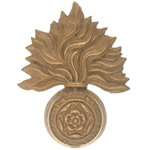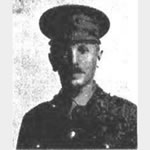Commemorated: | |||
| 1. Memorial: | Loos Memorial | Panel 130. Loos | |
| 2. Book: | The (1921) Masonic Roll of Honour 1914-1918 | Pg.123 | |
| 3. Memorial: | The (1940) Scroll - WW1 Roll of Honour | 55C GQS | |
| 4. Book: | De Ruvigny's Roll of Honour | Vol 2 | |
Awards & Titles: | |||
Family :
Son of Sydney Gedge, of Mitcham Hall, co. Surrey, Solicitor, by his wife, AugustaService Life:
Campaigns:
- The First World War 1914-1918, World-wide.
| Unit / Ship / Est.: 3rd Battalion London Regiment (Royal Fusiliers) |
1/3rd (City of London) Battalion (Royal Fusiliers) August 1914 : at Edward Street in Hampstead Road. Part of 1st London Brigade, 1st London Division. Moved on mobilisation to guarding the Basingstoke-Eastleigh railway. 4 September 1914 : sailed with Brigade from Southampton to Malta, arriving Valetta 14 September. 2 January 1915 : left Malta, arrived at Marseilles on 6 January. 10 February 1915 : joined the Gharwal Brigade in 7th (Meerut) Division. 17 February 1915 : transferred to Dehra Dun Brigade in same Division. 4 November 1915 : transferred to 139th Brigade in 46th (North Midland) Division. 16 November 1915 : transferred to 142nd Brigade in 47th (2nd London) Division. 9 February 1916 : transferred to 167th Brigade in 56th (London) Division. 3 January 1918 : transferred to 173rd Brigade in 58th (2/1st London) Division, absorbed the disbanded 2/3rd Bn and renamed 3rd Bn. |
| Action : The Battle of Loos and associated actions |
"The Battle of Loos (25 September to 18 October 1915) was the major battle on the Western Front in 1915, surpassing in every respect all that had gone before in terms of numbers of men and materiel committed to battle. The preliminary bombardment was the most violent to date and the battle was charaterised by the committment of Regular and Territorial battalions on a large scale, in which the Territorials performed just as well as the Regulars. As the battles on the Western Front in 1915 increased in size and violence, so the casualties increased in proportion: Neuve Chapelle 12,000, Aubers Ridge/Festubert 29,000 , Loos 60,000. 1916 was to take the casualty cost to another level. Loos was intended as a minor role in support of French efforts around Arras but circumstances reduced the French effort. It marked the first use of poison gas by the British. Once the initial assualt had failed the battle continued in a series of actions mostly focused on the northern sector around the tactically important Hohenzollern Redoubt."
Detail :
GEDGE Cecil Bertie, 2/Lieutenant 1/3 London Regiment The Battle of Loos marked the first use of poison gas by the British Army. The battle was fought over the industrial coal mining villages north of Lens and started on 25th September 1915. In order to unbalance the Germans and to prevent them from rapidly moving reserves from quiet sectors a series of feint attacks were staged. One of these was north of Neuve Chapelle at Pietre and it was there that Cecil GEDGE lost his life. The attack was delivered by the Indian Corps to which the 1/3 London Regiment was attached. The attack started with an indifferent smoke and gas screen which in fact caused the assaulting brigades more problems than it did to the German defenders. The Garhwal Brigade, of which the 1/3 Londons were part, advanced to find that the wire was not cut and it sustained large casualties as men desperately sought a way through. Eventually the Garhwal Brigade attach stalled in front of the German trenches and made no significant progress. On their flank the Bareilly Brigade accompanied by the 2/8 Gurkha Rifles made progress but found themselves isolated and susceptible to German counter attack which soon developed. The mud and the congested British communication trenches prevented support reaching the Bareilly Brigade and under severe pressure from German troops armed with much superior grenades, it was forced to return to its original front line. The feint was effectively over and probably had little impact on events to the south at Loos. The cost of the Pietre action was 107 officers, 1172 British other ranks and 1788 Indian other ranks.
Cecil GEDGE was almost certainly killed in the Garhwal Brigade advance that was stopped on the German wire. One source tells us that "He went to France in June 1915 when he was attached to the Grenadier Coy., Garhwal Brigade, and was killed in action at the Battle of Loos on 25 September. His Colonel wrote: He was wounded early in the advance and came back and had his wounds dressed, and then went out again to lead his men, and he has not been seen since. He was a brave English gentleman, and we are glad to think he was one of us. I am very sorry to say I have had strict orders not to send forward for 'Mention' any officer who has been killed. If it were not for this very strict rule I should have sent forward your husband's name. A brother officer wrote: There is one thing that may console you, and that is, your husband showed the greatest courage. He was wounded by shrapnel early in the morning, but refused to go back. He just had his men bind him up, and when the order came to go over the parapet, he led his men over like a hero. Cecil was a Member of the Inner Temple having followed his father into the law. He was born on 20th February 1866 so at 49 was certainly not a young man when he was killed. He was educated at Eton and Trinity College Cambridge. He was called to the Bar (Inner Temple) as a barrister in 1891, and afterwards practiced on the South-Eastern Circuit and at the Essex and Herts Sessions. On the outbreak of war he enlisted in the 23rd Middlesex Regiment (The Sportsman's Battalion) and was later commissioned as a 2nd Lieutenant in the 1/3 London Regiment in April 1915. His decision to enlist in the Sportsman?s Battalion was no doubt influenced by him being a good sportsman, being well known in Switzerland as a curler. He was a member of the MCC. He was also a keen scholar, and had edited various publications, including Granta in 1890, Huts, 1902-3, and was sub-editor of Lord Halsbury's Laws of Ayland. He married. Jessie Bickley at St. Margaret's, Westminster on 6 Aug. 1892, and had a daughter Sydney Jessie in 1893. 2/Lieutenant Cecil GEDGE is remembered at St James's Church in Stedham, West Sussex and on the Mitcham War Memorial and is also named on a family grave in the nearby churchyard of St.Peter and St.Paul. The Masonic Roll of Honour 1921 incorrectly suggested he was a Captain. Sources Official History Military Operations France and Belgium 1915 Vol II Du Ruvigny's Roll of Honour: MCC Roll of Honour
see also Rother Valley War Memorials.
Masonic :
| Type | Lodge Name and No. | Province/District : |
|---|---|---|
| Mother : | Golders Green No. 3410 E.C. | London |
Initiated | Passed | Raised |
27th October 1913 | 24th November 1913 | 30th November -0001 |
Source :
The project globally acknowledges the following as sources of information for research across the whole database:
- The Commonwealth War Graves Commission
- The (UK) National Archives
- Ancestry.co.uk - Genealogy, Family Trees & Family History online
- ugle.org.uk - The records of the United Grand Lodge of England including the Library and Museum of Freemasonry
Additional Source:
- Founder Researchers : Paul Masters & Mike McCarthy
- Researcher : Bruce Littley

